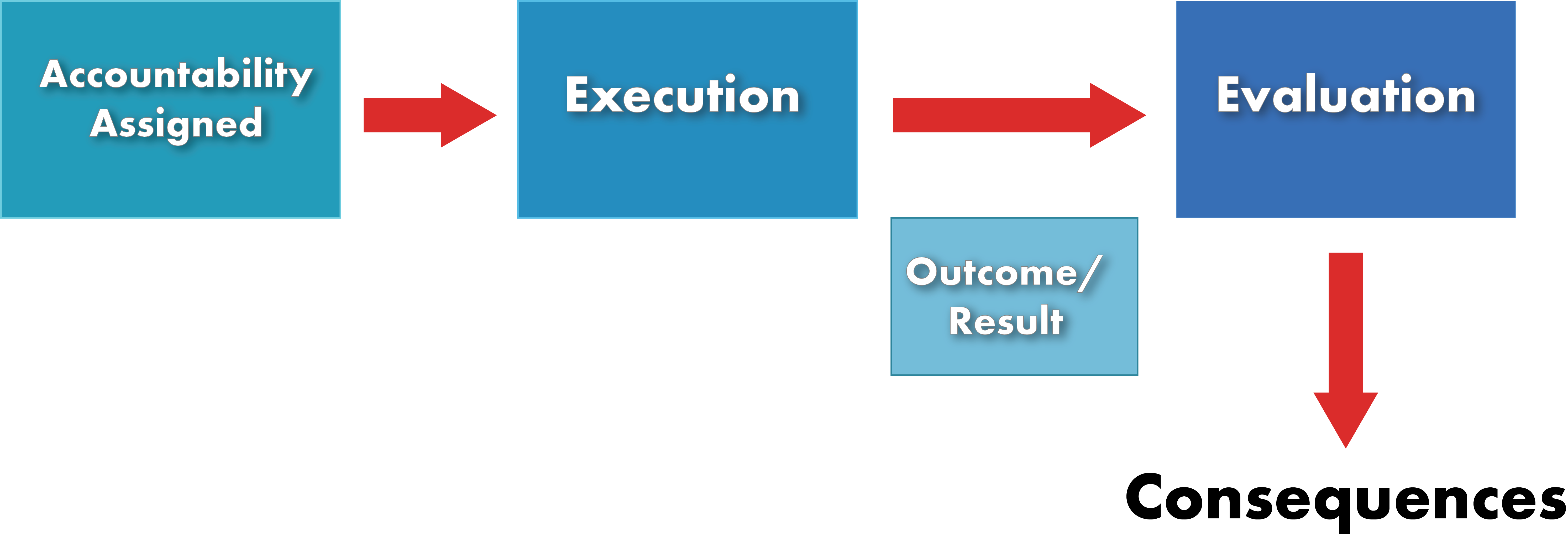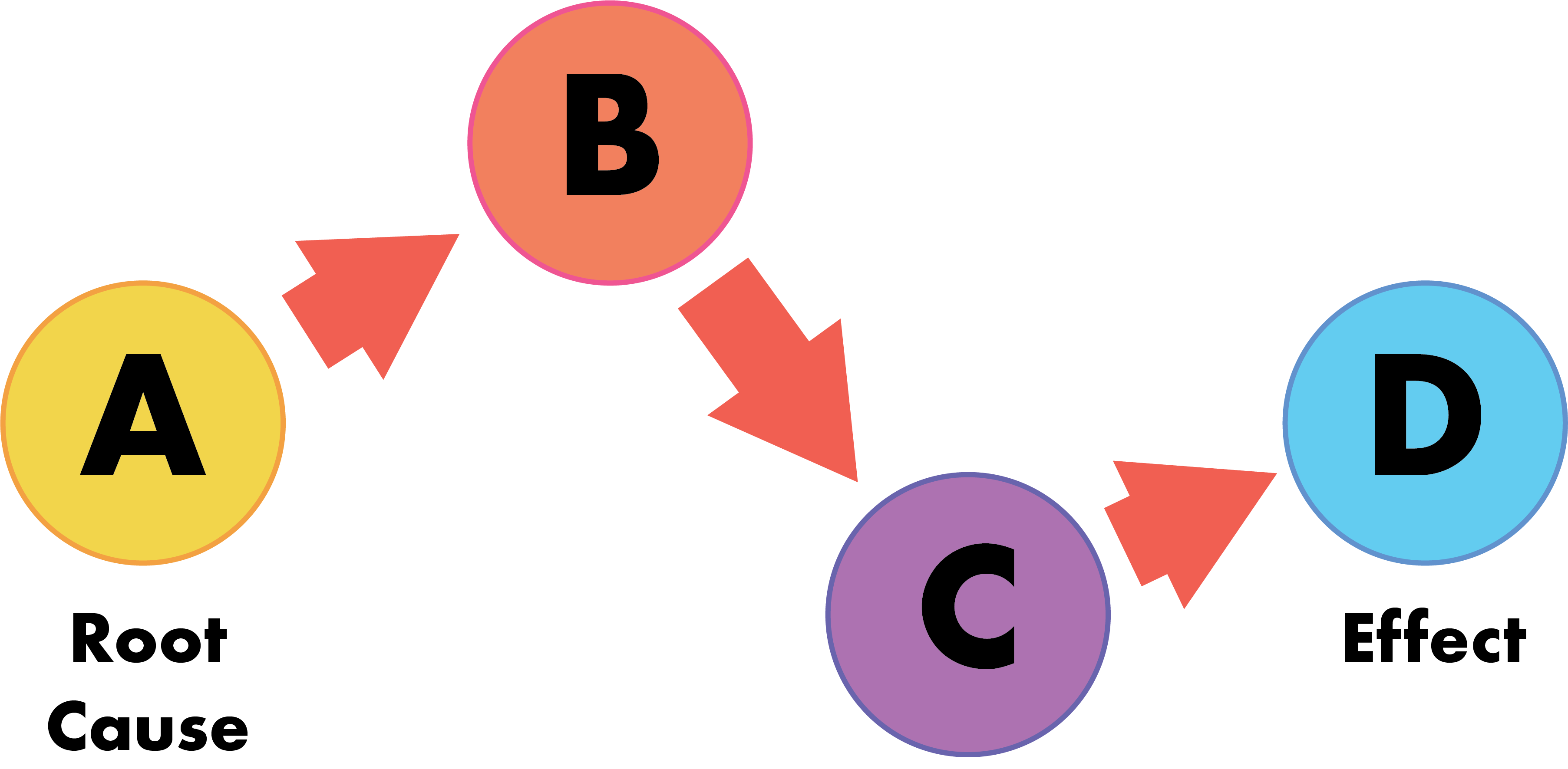Matrix Management Wiki
Home » The Accountability Key » 2A. Vertical Management 1.0 Accountability System
- 2A1. The system of accountability used in the VM 1.0 OS is designed to work in a one-dimensional organization.
- 2A1i. It requires authority and control to get things done.
- 2A1ii. It is activity driven.
- 2A1iii. Goals are deployed down through the vertical organization and each vertical or resource leader is accountable for the goals of his individual area only.
- 2A1iv. Goals are then broken down into activities and given to professionals to perform. Professionals are accountable for completing tasks.
- 2A2. The VM 1.0 Accountability Process
- 2A2i. Figure 2.1. Steps in the VM 1.0 accountability process.

- 2A2ii. In VM 1.0, the boss gives out an assignment, and the direct report must accept the assigned accountability (Accountability Assigned).
- 2A2iii. The direct report then executes the work (Execution) and tracks the activities that are performed.
- 2A2iv. After work is complete and the results are in, the success or failure of the effort is evaluated (Evaluation).
- 2A2v. If the work didn’t meet the boss’ expectations, the cause of failure is determined and then blame is assigned. Consequences are applied.
- 2A2vi. Consequences can be good or bad, but since VM 1.0 is focused on avoidance of failure, consequences are often punishment-oriented and therefore negative.
- 2A2via. Negative consequences include such things as finger-pointing, blame, less desirable future assignments, negative feedback, negative performance reviews, no merit pay increases, a change of job for the worse, being fired, etc.
- 2A2vib. Positive consequences can include praise, recognition of any kind, positive performance evaluations, promotions, monetary rewards, etc.
- 2A3. The premises that drive VM 1.0 accountability drive the principles and rules that cause organizations to struggle to deliver results.
- 2A4. Premise #1: Any outcome that occurs within an organization can be traced back to a single cause.
- 2A4i. The underlying belief is that an organization is composed of independent parts, which make it a nonsystem. In a nonsystem, it’s possible to trace the cause of a result to a single event.
- 2A4ii. Figure 2.2. Root causes and effects in VM 1.0 accountability.

- 2A4iii. As seen in Figure 2.2, when effect “D” is observed, it is assumed that one can identify the single root cause “A” of that effect. The belief is that if you correct “A”, then “D” won’t happen again.
- 2A4iv. Principles/rules related to Premise #1:
- 2A4iva. If something goes wrong, find the root cause for what happened and fix the cause, so it doesn’t happen again.
- 2A4ivb. Since you can identify a single cause for any outcome, one, and only one, person can be the cause of any specific outcome. The person who is the cause is accountable for the effect.
- 2A4ivc. The way to change an outcome is to find one person to blame when something goes wrong and correct that person, so he doesn’t do it again.
- 2A4v. Why Premise #1 is wrong: An organization is a system, not a nonsystem, and so the parts are interdependent. In a system, there are multiple causes for any effect.
- 2A5. Premise #2: If more than one person is accountable for a goal, then no one is accountable.
- 2A5i. The underlying belief is that shared accountability is no accountability at all,
- 2A5ii. because you need to be able to hold a single person accountable (the person who is the single cause) when something goes wrong.
- 2A5iii. One of the effects of Premise #2 is that if only one person is accountable for a goal, there is no incentive for others to support that goal because they have their own individual goals to worry about.
- 2A5iv. Why Premise #2 is wrong: The premise is based on finding a single person to blame when something goes wrong, which refers back to the reasons why Premise #1 is wrong.
- 2A6. Premise #3: You need to have authority over someone in order to get them to do what you need or want them to do.
- 2A6i. The underlying belief is that people don’t like to work, so you need to have control over people if you want them to work hard and to do the right things.
- 2A6ii. Principles/rules related to Premise #3:
- 2A6iia. The boss must have authority over the resources that do the work.
- 2A6iib. Accountability can only be assigned by the person who has authority over that person.
- 2A6iii. Why Premise #3 is wrong: You cannot control another person. The only person you can control is yourself. Even in extreme environments, such as concentration camps, the best you can hope to control is a person’s actions; but even there, you cannot control their minds, hearts, or spirits. That is a choice only they can make. Therefore, authority is not the most effective tool for getting a team of people to do what you want.
- 2A7. Premise #4: Punishment helps to avoid mistakes.
- 2A7i. The underlying belief is that people succeed in order to avoid punishment.
- 2A7ii. Principles/rules related to Premise #4:
- 2A7iia. Find the root cause of a failure of accountability and apply consequences so the mistake doesn’t happen again.
- 2A7iii. Why Premise #4 is wrong: People are intrinsically motivated to succeed, and punishment only creates fear which in turn diminishes intrinsic motivation. Punishment also reduces risk-taking and creative thought.
- 2A8. Premise #5: If each person achieves his individual goals, then the organization as a whole will achieve its goals.
- 2A8i. The underlying belief is that the whole is the sum of its parts.
- 2A8ii. Principles/rules related to Premise #5:
- 2A8iia. Have one, and only one, person accountable for each goal to ensure organizational goals, as a whole, are achieved.
- 2A8iii. Why Premise #5 is wrong: The whole is not the sum of its parts, and optimizing the parts (the individual goals) suboptimizes the organization as a whole.
- 2A9. An organization experiences specific symptoms when operating with VM 1.0 accountability:
- 2A9i. There is a culture of fear and blame.
- 2A9ii. Time is wasted making excuses, covering one’s backside, and blaming others in order to get out of being held accountable.
- 2A9iii. Team and organizational goals aren’t achieved due to the focus on individual goals.
- 2A9iv. Projects aren’t completed within agreed scope, schedule, or budget.
- 2A9v. Professionals (called individual contributors in VM 1.0) and leaders are unempowered.
- 2A9vi. There is a lack of responsible decision making and risk taking.
- 2A9vii. Performance management systems drive individual optimization.
- 2A9viii. Functions, not the overall organization, are optimized.
- 2A9ix. It is difficult for leaders to lead without authority.
- 2A9x. There is competition within teams as well as between teams and individuals.
- 2A9xi. The organization is focused on activity.
- 2A9xii. Reacting is more important than being proactive.
- 2A9xiii. The culture does not foster learning.
- 2A10. VM 1.0 Performance Management
- 2A10i. In the VM 1.0 OS, performance management is used to try and maximize individual performance.
- 2A10ii. The boss does the performance review based on his analysis of an individual’s performance.
- 2A10iii. An individual’s performance is often measured against the performance of other individuals.
- 2A10iv. Goals are set at the beginning of the year and the evaluation of whether or not those goals were met is done at the end of the year.
- 2A10v. Only individual accountability is measured.
- 2A10vi. The boss is not held accountable for performance of the subordinate. If an individual fails or needs to be fired, the boss is usually not held accountable for the failure.


